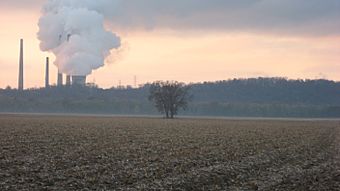State Line Archeological District facts for kids
Quick facts for kids |
|
|
State Line Archeological District
|
|

Fields in the district
|
|
| Location | On the Indiana/Ohio line, 2 miles (3.2 km) north of the Ohio River |
|---|---|
| Nearest city | Elizabethtown, Ohio |
| Area | 8 acres (3.2 ha) |
| NRHP reference No. | 75001423 |
| Added to NRHP | July 24, 1975 |
The State Line Archeological District is a special place where scientists study old Native American villages. It's also called the State Line Site. This historic area is found near Elizabethtown, Ohio, right on the border between Indiana and Ohio. It covers about 8 acres of land and has five important spots where ancient things were found.
Experts believe this was once a village of the Fort Ancient culture. These were Native American people who lived in this area a very long time ago.
Contents
Who Lived at State Line?
Scientists use a method called Radiocarbon dating to find out how old things are. This method showed that the State Line site was used around the same time as two other ancient villages: the SunWatch Indian Village near Dayton, Ohio and the Turpin Site near Newtown, Ohio.
After studying the items found at these places, experts learned that the people from all three sites belonged to the same culture. They were all part of the Middle Fort Ancient period. This means they lived there around the 1200s, which was the thirteenth century AD.
Discoveries at the Village Site
A big part of the State Line District is a village area, sometimes called the "Henry Bechtel Village." This area has a large midden, which is like an ancient trash pile. It also has a cemetery where people were buried.
When farmers plow the fields in this village area, they often find many old items. These include burial pits, hearths (old fireplaces), and trash pits.
Ancient Pottery
Scientists have found many pieces of pottery during their digs at the site. This pottery was usually made with crushed shells mixed into the clay. This made the pottery stronger.
The pottery found here looks a lot like the pottery made by other groups from the Mississippian culture. For example, it has special painted designs. Some pieces even look like owls or human heads.
Because the ancient trash pile (midden) is wide but not very deep, scientists think something interesting. They believe many people lived in the village, but maybe only for a short time.
Mysterious Burial Mounds
The district also has three small burial mounds. These are hills of earth built over graves. It looks like these mounds were made by even older groups of people, known as Mound builders.
Long ago, there were five mounds at this site. But today, only three of them are still within the district's protected area.
Protecting History
In 1975, the State Line Archeological District was added to the National Register of Historic Places. This is a special list of places in the United States that are important to history. It was listed because of its great importance for understanding ancient cultures and history.



